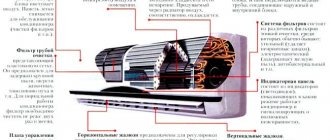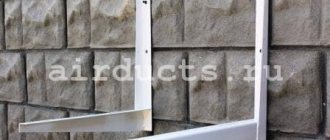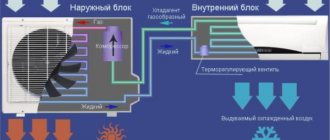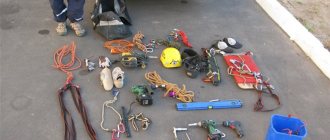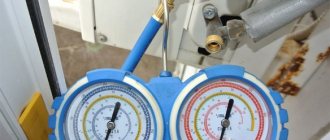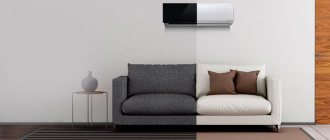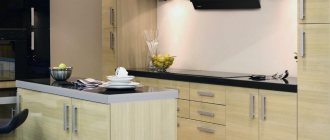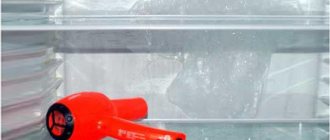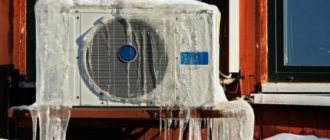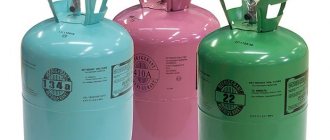How does an air conditioner work?
The system operates on a closed cycle principle. The air in the room is cooled by passing through the heat exchanger of the indoor unit, in which the refrigerant evaporates. Let's look at the operation of the device step by step.
- The compressor installed in the outdoor unit compresses the refrigerant and pumps it into the condenser in a gaseous state from the evaporator of the indoor unit.
- In the condenser, the freon is cooled due to heat exchange with the outside air and condenses. All this happens in the heat exchanger of the external unit.
- Next, the refrigerant passes through a throttling device, where a sharp decrease in freon pressure and temperature occurs. In this case, part of the liquid refrigerant inevitably turns into a gaseous state.
- Cold freon enters the heat exchanger of the indoor unit (evaporator), where, due to heat exchange with the air from the room, it boils and passes from a liquid to a gaseous state. The air, in turn, is cooled and enters the room.
Due to the way the air conditioner operates, drops of water—condensation—form on the evaporator. Typically, when installing a system, a separate pipe is installed to drain condensate. It goes outside or into the sewer so that there is no excess moisture in the room.
The direction of the exhaust air from the indoor unit is adjusted using a special curtain and blinds horizontally and vertically.
Features of the air conditioner for heating
Everything is very simple! The main reason is that when working with heat, condensation (water) forms on the external unit (or rather on its radiator), which should not freeze.
By rotating the fan of the indoor unit, the temperature of freon condensation in the system is regulated. While the fan is “standing,” the gas temperature in the indoor unit rises (the heat exchanger heats up). At the same time, temperature parameters are adjusted to maintain the processes of evaporation and condensation of the refrigerant (freon).
When the indoor fan stops, you can hear the air conditioning compressor continue to operate. This increases the pressure and, in turn, the temperature of the gas in the system.
Thus, the heat exchanger of the indoor unit warms up the air in the room well. And at the same time you will not feel the cool flow. In cooling mode, the fan does not stop because freon evaporates in the indoor unit. At the same time, ice formation does not occur on it (of course, if the system is in working order and all operating conditions are observed).
Therefore, periodic stopping of the indoor unit is “normal” operation of the air conditioner in heating mode. And be sure that the air conditioner is turned on correctly.
How does an inverter air conditioner work?
The peculiarity of this device is that the compressor turns on once during the entire operation of the air conditioner and remains in this state constantly, changing the speed depending on the load on the air conditioner. In turn, a conventional air conditioner (on/off) periodically turns on and off without changing the speed. The inverter saves energy and extends the life of the compressor, since it works without turning on/off, but smoothly changing the number of revolutions.
An inverter model will be more economical than any other air conditioner if it runs for at least several hours without turning off.
The inverter model, like a conventional air conditioner, has two units - external and internal. The external one contains a compressor, copper freon pipelines, a fan and a condenser. The indoor unit consists of an evaporator, a fan, blinds, a filter and a special tray for the condensate formed.
How does an air conditioner work?
Air conditioners are used to regulate and maintain optimal temperature in rooms. Climate control equipment is installed in private houses, apartments and work premises. In order for the device to work effectively for a long time, you need to study the operating rules of air conditioners, understand the principle of its operation and study the technical features of the device.
In the article we will look at everything that is important to know about the design of a typical air conditioner, the technical diagram of the equipment, how the air in the room is cooled and heated.
Table of contents:
Design and principle of operation of a split system
The usual classic split system consists of two modules (blocks) - external and internal. The design of the external unit of an on/off type split system is almost always the same.
External unit
The external unit includes a compressor, a condenser, a four-way valve, and also has a capillary tube.
All units contain a filter drier that cleans and dries the refrigerant from possible moisture entering the system and various types of contaminants. In inverter-type split systems, the external unit also contains a control board, which is also found in multi-split systems. Due to the fact that the compressor is located in the outdoor unit, the noise level from a working air conditioner in the apartment is much lower than from the street. The dimensions of the external unit may vary depending on the performance of the model, as well as the brand.
The indoor unit is connected to the external unit using freon pipelines. There is also a drainage line and an electrical cable to power the indoor and outdoor units.
The external unit of the air conditioner should always be located on the street side. It is attached to the outside of the wall. If the air conditioner needs to be installed at a sufficient height from the ground and it is not possible to mount the outdoor unit in the usual way, then climber installers with special gear and equipment are invited. Without such devices it is impossible to install the external unit high. Also, the outdoor unit can be installed on the roof of buildings, on unglazed balconies and loggias, open common balconies or flights of stairs with open access to the street. Often external blocks are supplied in a vandal-proof casing; if this is not provided by the manufacturer, then a block installed at the level of the first floors can additionally be placed in a special protective box made of metal rods. To prevent the accumulation of snow or rainwater, as well as debris, a special sloping canopy is sometimes installed over the external units.
Indoor unit
The internal units of a split system differ significantly from each other. Firstly, it depends on the manufacturer, i.e. all internal units differ in design, and secondly, the units differ in the type of installation, and, accordingly, have a significant difference not only in the design of the front panel, but also the housing as a whole. Also, indoor units, depending on the manufacturer, power and model, may differ in components, functionality, and overall dimensions.
Split system indoor units can be of the following types:
- wall-mounted – they are designed for installation on a wall;
- cassette - placed in the area of the ceiling space;
- duct - installed in the area of the ceiling space with an air duct system;
- floor-subceiling – can be installed both on the floor and in the area under the ceiling;
- columned - installed on the floor, they are large in size compared to other types of indoor units of classic split systems.
The operation of the indoor unit is regulated thanks to an electronic board. The indoor unit contains filters for air purification, automation, an evaporator and a fan for blowing the evaporator heat exchanger. The main functions of modern split systems are ventilation, dehumidification, cooling, heating and maintaining a given room temperature. Control using remote control. Almost all modern models of split systems are equipped with a remote control. With its help, you not only turn the device on and off, but also control all functions - setting the temperature mode, turning on the timer, programming tasks, turning on all modes provided for a specific air conditioner model. If the model has the “I feel” function, then thanks to the temperature sensor in the remote control, the air conditioner monitors the ambient air temperature in the room, and when the temperature set by the user is reached, the equipment maintains it. On the indoor unit, the direction of the air flow is adjusted by changing the angle of the blinds. The operation of the compressor of the external unit is regulated by constant monitoring of all systems.
Features of the functioning of floor air conditioners
These models are rarely used if a standard split cannot be installed. Floor-standing air conditioners are also only stationary. Stationary models have a similar operating principle as a conventional air conditioner, with the exception of the installation of an indoor unit. It is not located under the ceiling, but at a height of half a meter from the floor. The external unit is located on the street. Such split systems belong to the semi-industrial series. As a rule, they are more productive than household models.
Features of mobile models
The mobile model has only one unit and is located indoors. It contains a compressor, evaporator and condenser. The functioning mechanism is based on the processing of indoor air.
Usually it is not recommended to choose a mobile model, since the noisiest part will be installed not outside the window, but indoors. When the air conditioner is on, you will feel uncomfortable in the room. In addition, they are characterized by low power.
The principle of operation and design of the air conditioner
You will be surprised, but the air conditioner works very simply. For comparison: just drop water on your skin and while it evaporates, you feel cold. The principle of a household air conditioner is the same: the refrigerant, circulating, is cooled and heated. Let's understand how an air conditioner works in an apartment, what a split system is and what it consists of.
An air conditioner is otherwise called a split system (from the English split - division). It consists of two blocks: external and internal. The first is mounted on the wall from the street side, the second - indoors. Together they form a closed system for the movement of refrigerant - the working substance of the air conditioner.
External and internal units of split system (air conditioner)
Main components of the air conditioner
- compressor. Compresses the refrigerant, which heats up during the compression process, and maintains its movement along the refrigeration circuit;
- capacitor. Radiator located in the outdoor unit. In it, gaseous freon, cooled by blowing with street air, condenses to a liquid state;
- throttling device. Reduces pressure, reducing the temperature of the refrigerant;
- evaporator. Radiator located in the indoor unit. The principle of operation is the opposite of a condenser: in it, freon evaporates as the temperature rises;
- fans. Provide heat exchange between the indoor and outdoor units of the air conditioner with the environment;
- copper tubes through which the refrigerant circulates.
Outdoor unit design
The outer part of the air conditioner is placed on the wall on the street side. This allows for heat removal from the room and reduces the noise level in it. The outdoor unit consists of several basic parts:
- fan. In simple models it has one rotation speed. Expensive options require multiple speeds or smooth adjustment;
- capacitor. Home air conditioners use air-cooled condensers;
- compressor. There are classic rotary and double-rotor ones. The latter are distinguished by an almost complete absence of vibrations.;
- throttling device. In home air conditioners it looks like a capillary tube or an electronic expansion valve;
- control board. In the external module it is found only on inverter air conditioners.
Indoor unit design
The indoor unit is part of the split system, which is located in the room. It includes:
- decorative front panel of the case. Behind it are air filters and an evaporator (heat exchanger).
- coarse filter. A mesh that catches large particles at the entrance to the indoor unit: wool, hair, dust;
- fine filters;
- fan. Unlike the outdoor unit fan, as a rule, it has several speeds;
- evaporator. It is a copper tube with aluminum fins;
- horizontal blinds. Movable elements of the block that can be controlled using a remote control. They direct the air flow in the desired direction vertically;
- vertical blinds. In almost all household split systems they can only be adjusted manually. Direct the air flow horizontally;
- Control block. A control board is installed in a protected plastic box, to which the starting elements of motors and sensors are connected;
- indicator panel. Located on the front panel of the air conditioner and demonstrates the operating status of the equipment;
- drainage bath. A tray into which condensate drains from the surface of the heat exchanger. The condensate is then discharged into the sewer or outside through a drainage pipe.
Several indoor units can be installed in an apartment. Moreover, they can be connected to one outdoor unit.
Operating principle of the air conditioner
The basis of the process is the ability of liquids to absorb heat during evaporation and release it during condensation. A refrigerant circulates in the air conditioner, which, depending on temperature and pressure, changes its state of aggregation, that is, it becomes either a gas or a liquid.
Four basic units - a compressor, a condenser, a throttling device and an evaporator - are interconnected by tubes that create a refrigeration circuit within which the refrigerant moves.
Operating principle of the air conditioner
- Low temperature gaseous refrigerant enters the compressor from the evaporator. The compressor compresses the gas, simultaneously increasing the pressure and temperature of the refrigerant gas. Next, the hot refrigerant under high pressure enters the condenser.
- The gas cools down in the condenser, because is blown by a stream of colder air and turns into liquid, giving off heat. And the air leaving the condenser is heated due to the heat given off by the compressed refrigerant.
- Next, the refrigerant enters the throttling device. In this area it is somewhat warmer than atmospheric air, is in a liquid state and under high pressure. As it passes through the throttling device, the refrigerant pressure drops sharply. This is accompanied by a decrease in its temperature.
- At the end of the cycle, the refrigerant returns to the evaporator where it is exposed to room air. The refrigerant becomes a gas again, drawing heat from the room. And this cycle repeats as long as the air conditioner is on.
How to avoid breakdowns?
Perhaps one of the most difficult problems when operating a split system is the refrigerant that has not had time to turn into gas. From the evaporator, liquid enters the compressor inlet, and since liquid is an incompressible substance, water hammer occurs. The main reason for the breakdown is contamination of the filters of the indoor unit and clogging of the surface of the condenser of the outdoor unit with poplar fluff. Therefore, prevention is needed: regular cleaning and scheduled inspections by a specialist.
If you follow simple rules, the split system will last for many years, providing reliable and impeccable air conditioning.
What is the difference between an air conditioner and a split system
An air conditioner is complex technical equipment designed to create and maintain a comfortable temperature in a room for any purpose.
An air conditioner can not only cool the air, but also heat it, if provided by the manufacturer. Air conditioning is a general concept of climate refrigeration technology. There are many types of air conditioners available today. An air conditioner can be called both a household appliance for cooling air, for example, a window air conditioner or a mobile air conditioner, and a chiller - high-power industrial climate control equipment. For a more precise definition, there are names of air conditioners, for example, split system. A split system is an air conditioner consisting of two units - external and internal. The indoor unit includes a control system - automation, filters for air purification, a fan for blowing the evaporator heat exchanger and the evaporator itself. The external unit includes a compressor, a condenser, a four-way valve, a capillary tube and an automation system.
A household split system is most often installed in relatively small rooms; for example, a household wall-mounted split system is designed to create an optimal microclimate in rooms from 10 to 70 m2, depending on the power of the equipment. Therefore, such split systems are most often installed in apartments or small office spaces.
One indoor unit is capable of maintaining the temperature in one room; if you need to maintain the temperature in several rooms at once, then there are multi-split systems for this. This system involves connecting several indoor units to one outdoor unit at once.
There are also other types of split systems that are more suitable for large spacious premises - shopping centers, restaurants, business centers, etc. All of these split systems also have one internal and one external unit; they differ only in the internal units and performance. Indoor units are divided by type of installation - cassette, duct, column, floor-ceiling, column.
Split systems may differ in options and functions, depending on the model and manufacturer. For example, split systems may have different numbers of cleaning air filters. The number of modes may also differ - some air conditioners have the following popular modes - “I feel”, night mode, self-cleaning, auto-restart, auto-shutdown, self-diagnosis, turbo mode, intelligent defrost, etc.
Air conditioners and split systems
Devices that create a microclimate have a common name - air conditioners. Let's tell you what the difference is between air conditioners and split systems. Air conditioners can be made as a single unit or divided into indoor or outdoor units. In the first case, mobile or window air conditioners are usually used. The former can be moved indoors, but they have bulky pipes to move air. Window windows are installed in one block so that one side is located indoors and the other is located outside. They occupy part of the window opening and create noise during operation.
Split systems are divided into two blocks (compressor-condenser and evaporation), connected to each other by tubes and electrical wires. The noisiest part of the split system is located outside.
The use of such devices means fresh air and comfort Source vkrostov.ru
The difference also exists in terms of design. Window and mobile units are more bulky, and the internal parts of split systems come in a variety of shapes and colors and can often be installed on walls, floors or ceilings without disturbing the design of the room. Another difference is the possibility of not only cooling, but also heating the air.
A split system is more difficult to install. However, it offers more features and is more economical than conventional air conditioners.
Split systems are often installed in hotel rooms; what is it and what is it for? Let’s try to understand this in more detail.
How to choose a split system for your home
When choosing an air conditioner for home use, consider the size of the room. For a small room (up to 15-20 meters), a 7000 BTU system is suitable. For a room up to 25 square meters, it is better to choose a more powerful model - 9000 BTU.
Think about electricity costs and choose energy-saving A++ models, consumption of about 700-800 watts. If your budget allows, you can buy an A+++ air conditioner with a consumption of 500-600 watts.
Assess the noise level. If possible, listen to how the system works, because you will have to be in the room while the air conditioner is running. The permissible noise value for the indoor unit is 19-32 dB.
What you need to know about how an air conditioner works
An air conditioner is a complex and very capricious device. If you do not monitor its condition and signals, it will become unusable.
The operating principle of an air conditioner based on physics, namely the reaction of the liquid. During evaporation, heat is absorbed, and during condensation, it is released. In a sense, the device is similar to a refrigerator, since the principle of its operation is based on the evaporation and condensation of a refrigerant, which changes its properties when pressure and temperature increase or decrease.
During the evaporation process, freon takes away heat.
At school, in chemistry, they carried out the following experiments: they wiped their hands with a solution containing alcohol, while you felt cold. When alcohol evaporated, it took away body heat. Conversely, when vapor condenses into a liquid, it releases heat. Heat, as we know, is energy, and according to the law of conservation of energy, energy does not disappear or appear anywhere. For this purpose, the air conditioner has two units - external and internal. Below are examples of how an air conditioner works in an apartment. See also -
Which air conditioner manufacturer is the best in terms of price and quality
Advantages and disadvantages of air conditioners
If you are looking to buy an air conditioner or split system, you will want to know the pros and cons.
Advantages
- Ensuring a comfortable temperature in the room. Regardless of the weather outside, the split system will create a favorable atmosphere in the room. In the summer, the air conditioner will cool the air, and in the fall or spring it will heat it up. In any case, it will be comfortable to be in the room.
- Clean indoor air. This is especially true for residents of large cities living in industrial areas. Using an air conditioner will allow you to get cool, clean air without opening the windows.
- Maintaining optimal air humidity. Some models have a dehumidification function, creating an optimal level of humidity in the room.
Flaws
Please note that the air conditioner can cause harm to humans only if used incorrectly. If you do not clean the unit regularly, harmful bacteria and viruses can begin to multiply in it.
Due to the way the air conditioner operates, the air in the room becomes drier, so we recommend using separate devices that increase the humidity level in the room.
Compressors make a little noise during operation. Usually the compressor is located in the outdoor unit, and you can’t hear it working indoors.
Air conditioner operation: heating
Now let's see what happens if you turn on the air conditioner for heating. The coils change their purpose. The one located outside will take away heat, the room one will be hot. The temperature outside the window is lower, and the operation of the system makes less sense. Please note: to organize the operation of the air conditioner for heating, the compressor now pumps freon towards the room.
It would seem easier to do by forcing the blades to work in reverse mode, but it is practically difficult to implement; in reality, a special valve with four strokes is used. By switching the state of the part, the direction of movement of the freon is changed. The compressor does not notice anything, it works, driving through the cruising mode.
What happens inside the air conditioner that controls the heating. The compressor and evaporator are located in the external unit, and the condenser is located in the internal unit. Heating mode is in progress. It turns out that the compressor crankcase, filled with oil, is exposed to the street. The temperature drops sharply, the lubricant thickens, and increased wear of the equipment begins. Avoid turning on most air conditioners for heating at temperatures below 0 ºС (see instructions for more details).
The second factor that makes the operation of an air conditioner for heating in winter becomes difficult is the performance of the system. The device is unable to generate heat; it simply pumps it from the street and gives it to the room. At shockingly low temperatures, the air conditioner, like a heater, becomes useless. The way out of this situation is by using a special brand of freon (according to unverified information, R410A). According to the documentation, air conditioners heat at minus 25 ºС outside the window. But! With one condition - the installation kit is equipped with a winter road. The term implies a set of properties that includes three components:
- Electronic board that reduces the compressor speed.
- Crankcase heating jacket with oil.
- Heating cable of the drainage path.
For reference. In cooling mode, the indoor unit accumulates an abundance of condensate from room water vapor. To solve the problem, a drainage branch is laid next to the freon line, through which the liquid is drained out. Light frost traps water, ice forms, and the operation of the device is disrupted. To avoid this phenomenon, a special heating electric cable is laid next to the drainage tract, melting the ice when the need arises.
Only if the mentioned kit is available, the air conditioner can be started at sub-zero temperatures. Please note: the standard installation is devoid of exotic elements. The winter road option costs extra money. In cruising mode, despite the instructions, it is better to avoid touching the device at temperatures below zero.
Car enthusiasts have asked three times why not pour winter oil into the crankcase when the temperature drops. The branch of copper tubes is sealed until the possibility is provided. This will greatly complicate the maintenance of the air conditioner. Now let's discuss monoblocks, we promised!
Maintenance and repair
It is necessary to regularly clean the air conditioner and carry out preventative maintenance to ensure that all systems are in good working order. You can clean the filter yourself, knowing the design of the model, or call a specialist who can handle it in 30-60 minutes.
If the air conditioner breaks down, do not repair it yourself, call customer service and describe the problem. Sometimes breakdowns are resolved within a few hours on site. For example, if the split system shuts down due to overheating after prolonged operation, the reason most likely lies in the compressor overheating or a dirty radiator. The problem is solved by cleaning the grille.
If the unit is not operating at full capacity, check the air filters. They may need to be cleaned.
